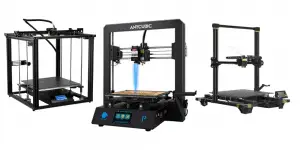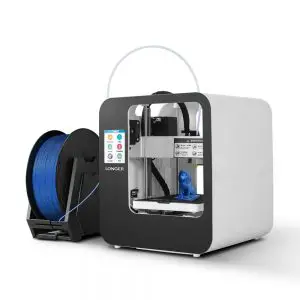This Offical Creality Open Source CR-10 V2 review identifies what you need to know before purchasing the Creality CR-10 3D printer. This machine from Creality has been upgraded since its debut in 2017 to enhance the DIY enthusiasts’ 3D printing experience.
Here are the technical specifications of the Creality CR-10 V2:
Creality CR-10 V2 Technical Specifications
| Build Volume: | 300 mm x 300 mm x 400 mm |
| Build Speed: | 30 - 180 mm per second |
| Connectivity: | SD Card, online |
| Software: | Cura, Repetier-Host, Simplify3D |
| Print Bed: | Glass, Removable, Heated |
| Leveling: | Manual with ability to upgrade to auto-leveling |
| Filament: | PLA, ABS, Wood, PETG, TPU, HIPS, Nylon |
| Filament Diameter: | 1.75 mm |
| File Types: | OBJ, STL, AMF |
| Nozzle: | .40 mm single extruder |
Design & Features
One of the first things you’ll notice after assembling the Creality CR-10 3D printer is the triangular structure of its all-metal extrusion frame that creates a stable piece of machinery to print with. There are many parts that can be upgraded along with open-source firmware which allows for easy modification.
The printer’s single extruder nozzle is a standard hot end but can be swapped out for other nozzles that are able to handle higher temperatures for printing with exotic filaments. The hot end comes equipped with dual cooling fans and a Titan direct drive with Bowden tubing to feed the filament into the nozzle.
The 350-watt power adapter by Meanwell is built into the control box for a secure and stable electric power supply. You’ll also find a quiet motherboard inside the control box with upgraded firmware to increase precision and operational stability. The control box is easy to navigate for most users with a knob that turns and can be pushed to toggle items throughout the menu. The Creality CR-10’s menu options let users level the bed but also control the temperatures of the hot end and the print bed while providing some pre-set options to make using the 3d printer even easier.
Other upgraded features include the BL-touch auto-leveling attachment that can be added to the Creality CR-10. The standard manual leveling feature offers larger sized nuts to make the process easier. The carborundum glass print bed is heated and can be removed. It provides some good adhesion but comes with some spare tape to make necessary adjustments when printing with a wide variety of materials.
Should you decide to switch materials in the middle of a build, there’s a filament runout detection sensor that allows the build to pause should you run out or swap colors. The dual cooling fans help prevent the clogging of the extruder. The Creality CR-10 is also equipped with a power loss recovery option to let builds resume printing should the power be cut at any point during the process.
The Creality CR-10 is a 3D printer for novices and experts as it leaves a lot of room to learn the process but isn’t so complicated it dissuades you from wanting to give it a try.
Printing
The Creality CR-10 3D printer is one of the quietest 3d printers on the market within the mid to low price range. Its upgraded TMC2208 ultra-silent drive keeps the printing noises under 50 decibels.
As is, the Creality CR-10 is an easy to use machine equipped with a single hot end that prints PLA and TPU filaments really well. The imported Titan direct drive with a Bowden transport tube maintains a steady 30 °C alongside the dual extruder cooling fans to help reduce plugging and spillage. This is especially useful if the filament needs to be swapped out in the middle of a print job.
The print bed heats up to a maximum temperature of 100 °C which allows you to work with a wide variety of filaments. However, the open build area forces users to take extra measures when printing with materials like ABS as this particular filament needs an environment that sustains a constant temperature. The print bed gives good adhesion and minimizes warping.
The suggested print speed ranges between 30 – 60 mm per second depending on the filament being used.
Packing
The Creality CR-10 is packaged and shipped as a DIY kit only requires some minor assembly. The open-source 3d printer allows for upgrades and modifications to be done easily. You can swap out the nozzle when printing with more exotic filaments like Nylon so it can handle hotter temperatures. Most users have been able to assemble the printer in under an hour.
- 1 x Aluminum Base with Print Bed
- 1 x Electronics housing unit with motherboard and hardware
- 1 x Gantry Assembly
- 1 x Sample Roll of PLA Filament
- 1 x SD Card
- 1 x USB SD Card Adapter
- 1 x USB Cable
- 1 x Manual Guide Sheet
- 1 x Filament Spool Holder
- 1 x Spare Print Nozzle
- 1 x Set of Screws
- 1 x Spare Bag of Screws
- 1 x Power Cord
- 1 x Spare Bowden Tube
- 1 x Clean Shovel / Scraper
- 1 x Roll of Tape
- 1 x Pack of Cable Ties
- 1 x Pair of Wirecutters
- 1 x Toolkit
Customer Support
Creality offers a 1-year limited manufacturer’s replacement part warranty and lifetime technical support. Take a look at the website for more details on what’s covered under the warranty protections for the Creality CR-10 3D printer. There are also online videos, forums, and communities available to troubleshoot issues. Technical support responds fairly quickly and offers up help whenever possible.
While the printer is easily upgraded and modified, certain alterations can void the warranty.
The Official Creality CR-10 V2 3D Printer Pros & Cons
Pros:
- A huge build area measuring 11.81 in x 11.81 in x 15.75 in is massive in comparison to other printers within the same price range
- The printer is easily assembled and its easily operated.
- The glass bed is heated and removable with good adhesion.
- The open-source firmware allows for upgrading and alternating the software that can be used with the machine.
- The control box is easy to navigate with a dial that can be turned and pushed to select specific menu options and settings.
- The CR-10 doesn’t need to be tethered to a computer to print.
- It’s a quiet printer making it operable in offices, classrooms, and labs.
Cons:
- The Creality doesn’t print well with materials that need consistent and constant heat.
- Auto-leveling doesn’t come standard which can make the prep process tedious.
- The placement of the filament holder can cause some tangling.
- The print bed can take a while to heat up.
Verdict
After this Creality CR-10 V2 review, it’s worth giving the 3D printer from Creality a try. The price point is attractive along with its massive build area. The Creality CR-10 is easy to assemble and has a wealth of information online to help beginners troubleshoot any issues that may arise. It’s easy to modify and upgrade for any 3D printing DIY enthusiast. For example, adding the BL-Touch attachment to provide auto-leveling is an upgrade recommended by Creality. The upgraded drivers and motherboard make for quiet printing. Having the ability to swap nozzles to adjust for exotic filaments is also a notable feature.
There are a number of sensors and alerts to let the most novice of users learn how the CR-10 works with an intuitive user interface. The triangular form of the all-metal printer creates a sturdy base to minimize vibrations which could cause prints to fail. All in all, this 3d printer has more going for it at its price point. The range of creativity possible can’t be quantified as industries like architecture and design, medical, animation, and robotics have found the Creality CR-10 to be a useful tool.
Last update on 2025-06-05 / Affiliate links / Images from Amazon Product Advertising API






